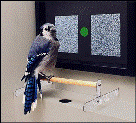Center for Avian Cognition

Avian Cognition Papers
Document Type
Article
Date of this Version
2012
Citation
Published in Animal Cognition 15 (2012), pp 37–44. doi 10.1007/s10071-011-0429-y
Abstract
What-where-when (WWW) memory during cache recovery was investigated in six Clark’s nutcrackers. During caching, both red- and blue-colored pine seeds were cached by the birds in holes filled with sand. Either a short (3 day) retention interval (RI) or a long (9 day) RI was followed by a recovery session during which caches were replaced with either a single seed or wooden bead depending upon the color of the cache and length of the retention interval. Knowledge of what was in the cache (seed or bead), where it was located, and when the cache had been made (3 or 9 days ago) were the three WWW memory components under investigation. Birds recovered items (bead or seed) at above chance levels, demonstrating accurate spatial memory. They also recovered seeds more than beads after the long RI, but not after the short RI, when they recovered seeds and beads equally often. The differential recovery after the long RI demonstrates that nutcrackers may have the capacity for WWW memory during this task, but it is not clear why it was influenced by RI duration.
Included in
Animal Studies Commons, Behavior and Ethology Commons, Cognition and Perception Commons, Forest Sciences Commons, Ornithology Commons, Other Psychology Commons


Comments
Copyright © 2011 Springer-Verlag. Used by permission.